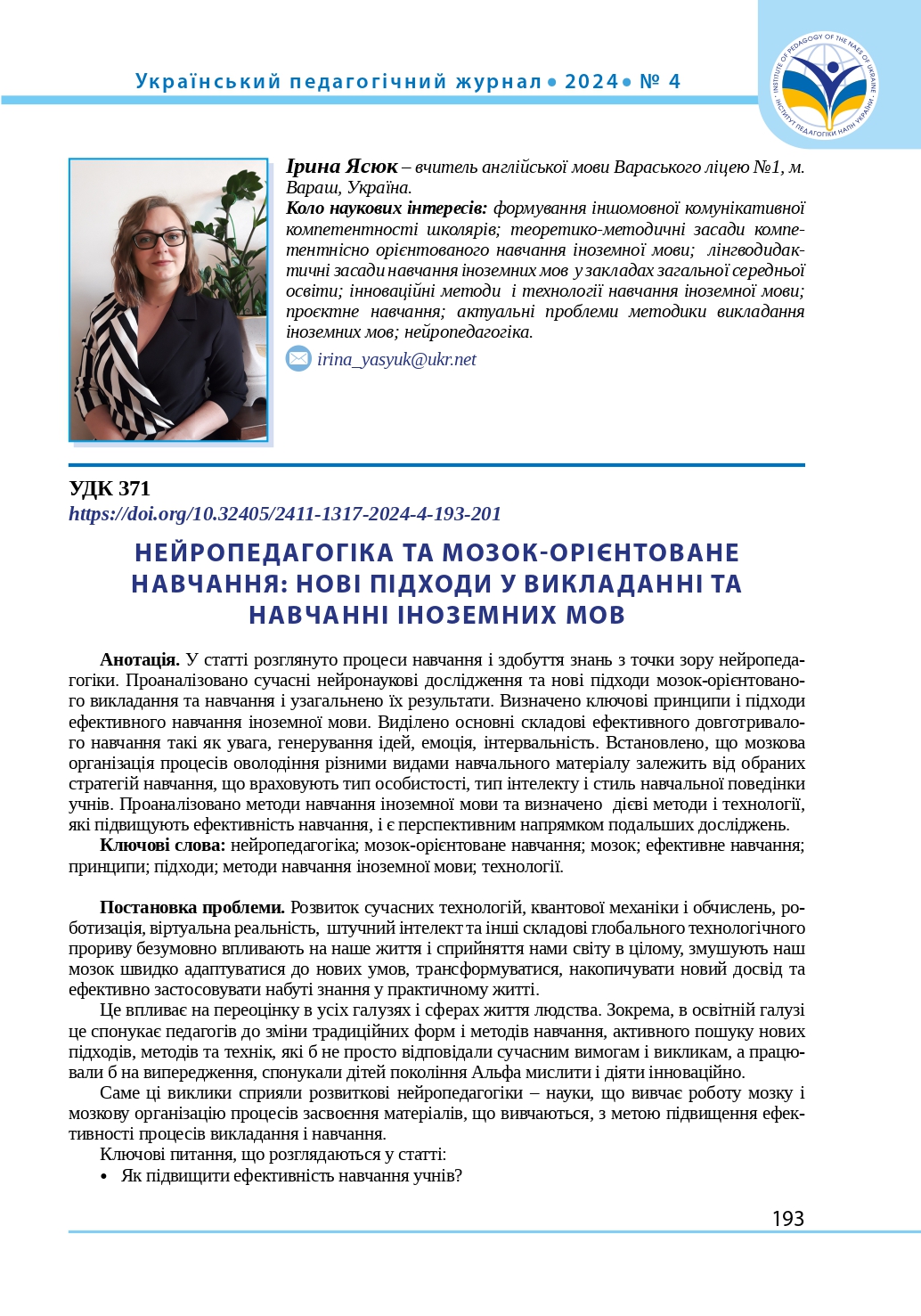Анотація
У статті розглянуто процеси навчання і здобуття знань з точки зору нейропедагогіки. Проаналізовано сучасні нейронаукові дослідження та нові підходи мозок-орієнтованого викладання та навчання і узагальнено їх результати. Визначено ключові принципи і підходи ефективного навчання іноземної мови. Виділено основні складові ефективного довготривалого навчання такі як увага, генерування ідей, емоція, інтервальність. Встановлено, що мозкова організація процесів оволодіння різними видами навчального матеріалу залежить від обраних стратегій навчання, що враховують тип особистості, тип інтелекту і стиль навчальної поведінки учнів. Проаналізовано методи навчання іноземної мови та визначено дієві методи і технології, які підвищують ефективність навчання, і є перспективним напрямком подальших досліджень.
Посилання
Вознюк, О.В. (2006). Англійська мова – це просто. У Інноваційні педагогічні технології (с.16-18). Житомир: Інформаційний центр ЖДУ.
Вознюк, О.В. (2019). Нейропедагогіка – потужний ресурс освіти дорослих. Андрагогічний вісник, 10, 19–27. http://library.zu.edu.ua/andragogichnyi_visnyk.html
Вознюк, О.В. (2005). Новітні нетрадиційні методичні напрямки викладання іноземних мов. Теорія та методика викладання філологічних дисциплін, 14, 69–80.
Вознюк, О.В. (2022). Технології інтенсивного навчання іноземних мов і культур: лекція. http://eprints.zu.edu.ua/31645/1/
Вовк, О., Зеня, Л., Броварська, І. (2022). Нейропедагогіка: концепція гармонійного навчання іноземної мови. Вісник Черкаського аціонального університету імені Богдана Хмельницького, 2, 64–73. https://doi.org/10.31651/2524-2660-2022-2-64-73
Завалко, К.В. (2022). Нейропедагогіка: теорія та методика Орф-пфдходу в музичному навчанні. Інноваційна педагогіка, 51(т І.), 80–85.
Руднік, Ю. (2013). Методика предметно-мовного інтегрованого навчання (CLIL): досвід. https://elibrary.kubg. edu.ua/id/eprint/2590/1/Rudnik_Y_MNPKL_PP_2013_FLMD_PI.pdf
Boaler, J. (2019). Limitless mind: learn, lead and live without barriers. New York, Harper Collins Publishers.
Brooks, M., & Brooks, J. (1993). In search of understanding. The case for constructivist classrooms. Alexandria, VA: Association fo Supervision and Curriculum Development.
Bruer, J. T. (1993). Schools for thought: A science of learning in the classroom. Cambridge, MA: The MIT Press.
Bruer, J. T. (1998). The brain and child development: time for some critical thinking. Public Health Reports, 113 (5), 388.
Bruer, J. T. (1999). In Search of Brain-Based Education. Phi Delta Kappan, 9, 648– 654.
Caine, R., Caine, G. (1991). Making connections. Teaching and the human brain. Alexandria, VA.: Association for Supervision and Curriculum Development, Available on: https://files.eric.ed.gov/fulltext/ED335141.pdf
Gruhn W., Rauscher F. (2008). Neuroscience in Music Pedagogy. Nova Biomedical books, New York, 121–143.
Jensen E., McConchie L. (2020). Brain-Based Learning: Teaching the Way Students Really Learn. Third edition. Corwin Press, Thousand Oaks, California.
Kidd J., Kaufman J., Baker P., O’Shea p., Dwight Allen & Old Dominion U students. (2024). Education 30: Introduction to education. How can brain research help teachers understand their students? Old Dominion University Foundations of Education and Instructional Assessment. LibreTexts, 234–236. https://socialsci.libretexts.org/Courses/Fresno_City_College/Education_30%3A_Introduction_to_Education_(Perez)/11%3A_Classroom_
Management/11.03%3A_How_can_brain_research_help_teachers_understand_their_students
Boaler, J. (2019). Limitless mind: learn, lead and live without barriers. New York, Harper Collins Publishers. (in English).
Brooks, M., & Brooks, J. (1993). In search of understanding. The case for constructivist classrooms. Alexandria, VA: Association fo Supervision and Curriculum Development. (in English).
Bruer, J. T. (1993). Schools for thought: A science of learning in the classroom. Cambridge, MA: The MIT Press. (in English).
Bruer, J. T. (1998). The brain and child development: time for some critical thinking. Public Health Reports, 113 (5), 388. (in English).
Bruer, J. T. (1999). In Search of Brain-Based Education. Phi Delta Kappan, 9, 648– 654. (in English).
Caine, R., Caine, G. (1991). Making connections. Teaching and the human brain. Alexandria, VA.: Association for Supervision and Curriculum Development, Available on: https://files.eric.ed.gov/fulltext/ED335141.pdf (in English).
Gruhn W., Rauscher F. (2008). Neuroscience in Music Pedagogy. Nova Biomedical books, New York, 121–143. (in English).
Jensen E., McConchie L. (2020). Brain-Based Learning: Teaching the Way Students Really Learn. Third edition. Corwin Press, Thousand Oaks, California. (in English).
Kidd J., Kaufman J., Baker P., O’Shea p., Dwight Allen & Old Dominion U students. (2024). Education 30: Introduction to education. How can brain research help teachers understand their students? Old Dominion University Foundations of Education and Instructional Assessment. LibreTexts, 234–236. https://socialsci.libretexts.org/Courses/Fresno_City_College/Education_30%3A_Introduction_to_Education_(Perez)/11%3A_Classroom_
Management/11.03%3A_How_can_brain_research_help_teachers_understand_their_students (in English).
Rudnik, Yu. (2013). Metodyka predmetno-movnoho intehrovanoho navchannia (CLIL): dosvid. https://elibrary.kubg. edu.ua/id/eprint/2590/1/Rudnik_Y_MNPKL_PP_2013_FLMD_PI.pdf (in Ukrainian).
Vovk, O., Zenia, L., Brovarska, I. (2022). Neiropedahohika: kontseptsiia harmoniinoho navchannia inozemnoi movy. Visnyk Cherkaskoho atsionalnoho universytetu imeni Bohdana Khmelnytskoho, 2, 64–73. https://doi. org/10.31651/2524-2660-2022-2-64-73 (in Ukrainian).
Vozniuk, O.V. (2005). Novitni netradytsiini metodychni napriamky vykladannia inozemnykh mov. Teoriia ta metodyka vykladannia filolohichnykh dystsyplin, 14, 69–80. (in Ukrainian).
Vozniuk, O.V. (2006). Anhliiska mova – tse prosto. Innovatsiini pedahohichni tekhnolohii. Zhytomyr: Informatsiinyi tsentr ZhDU, 16–18. (in Ukrainian).
Vozniuk, O.V. (2019). Neiropedahohika – potuzhnyi resurs osvity doroslykh. Andrahohichnyi visnyk, 10, 19–27. http://library.zu.edu.ua/andragogichnyi_visnyk.html (in Ukrainian).
Vozniuk, O.V. (2022). Tekhnolohii intensyvnoho navchannia inozemnykh mov i kultur: lektsiia. http://eprints.zu.edu.ua/31645/1/ (in Ukrainian).
Zavalko, K.V. (2022). Neiropedahohika: teoriia ta metodyka Orf-pfdkhodu v muzychnomu navchanni. Innovatsiina pedahohika, 51(t I.), 80–85. (in Ukrainian).

Ця робота ліцензується відповідно до Creative Commons Attribution-NonCommercial-ShareAlike 4.0 International License.

